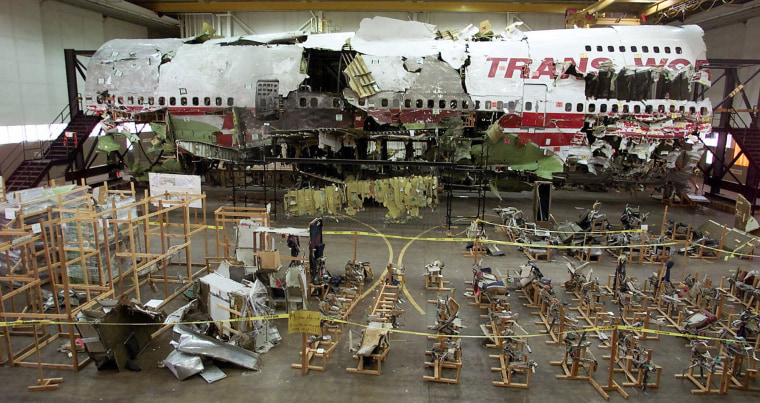A little past 8:30 p.m., as the blistering July sun melted in the west, a jumbo jet carrying students, honeymooners, businessmen and others to Paris exploded in a fireball, raining carnage into the Atlantic Ocean off Long Island.
It had been only a dozen minutes since TWA Flight 800 took off from Kennedy Airport.
Initially, investigators were not sure whether the calamity that killed all 230 people aboard the flight on July 17, 1996, was caused by a bomb, a missile or mechanical failure. Just two days before the start of the Summer Olympics in Atlanta, it was difficult not to suspect foul play.
People still question the official conclusion, reached in 2000, that TWA 800 was destroyed by an explosion in the Boeing 747’s center fuel tank, likely caused by a spark from a wiring short-circuit.
“I think it could have been somebody shooting at the plane, or it could have been a terrorist attack,” said Mona Morfis of Long Island, on a recent visit with her grandchildren to the seaside memorial garden that pays tribute to the victims and their rescuers.
Investigators stand firm
The man who spent years leading the federal investigation into the crash has no such doubts.
Robert Francis, the former vice chairman of the National Transportation Safety Board, still gets missives urging him to come clean about terrorism theories or witness accounts of a streak of light heading toward the plane.
Now retired and living in McLean, Va., Francis said he never responds to “very insulting e-mails, asking me when am I going to tell the truth and asking why am I lying.”
Because Flight 800 disintegrated over the ocean, Francis said, there was ample time for conspiracy theories to flourish.
“There was no ability to make a determination quickly,” he said. “We were picking up the wreckage in 130 feet of water.”
‘Show me something’
Investigators eventually recovered 98 percent of the wreckage from the ocean floor and painstakingly rebuilt a large part of the airliner.
“We studied if it had been a missile, what would it have done to the fuselage? We had scientists in the desert shooting rockets into old fuselages,” he said in a recent telephone interview. “We didn’t find a single piece of wreckage that would have pointed to that kind of explosion. So I say to the missile theorists: ‘Show me something.’ “
Another theory was that a missile from a Navy ship 200 miles away took down the plane, but Francis questioned why no one on the cruiser ever came forward. “You mean to tell me everybody kept their mouths shut?”
He said investigators also searched for evidence that a terrorist had launched a shoulder-fired missile from the nearby shore. “We never found any of that,” he said. “They searched every marina, every wharf.”
Taking comfort in conspiracy?
But why did so many people have doubts?
“It’s more acceptable to the public if somebody did this, rather than blame it on maintenance or design,” said Pete Field, a retired Marine Corps pilot who now works as an aviation crash consultant.
He said witnesses who claimed to have seen streaks of light heading toward the plane actually saw pieces of flaming wreckage falling, the official theory offered by the NTSB.
“You see trails (of light) and it’s easy to get your mind confused,” he said. “I do accident investigations all the time and I find that the mind traps an image, even if it’s not there. Even some aviation experts will tell you they saw something that just could not have happened.”
Doubts linger near crash scene
Eileen Best, who tends the garden at the TWA 800 Memorial at Smith Point County Park, said many visitors have shared their misgivings about the official conclusion.
“Many people on Long Island still have doubts,” she said as she prepared the garden for a 10-year commemoration on July 17.
In addition to the 230 people from 14 countries who perished, the memorial honors the hundreds of police officers, firefighters, rescue workers and boaters who raced to the scene.
A bench at the memorial is dedicated to the Rev. Mychal Judge, the New York Fire Department chaplain who was on duty on July 17, 1996, and acted as a counselor to the mourners for years afterward. Six weeks before he became the first official victim of the terrorist attack on the World Trade Center towers on Sept. 11, 2001, Judge joined relatives at a ceremony for the fifth anniversary of the TWA 800 crash.
“Every year that you come here, you make this spot more blessed and more sacred, if that’s possible,” Judge said.
